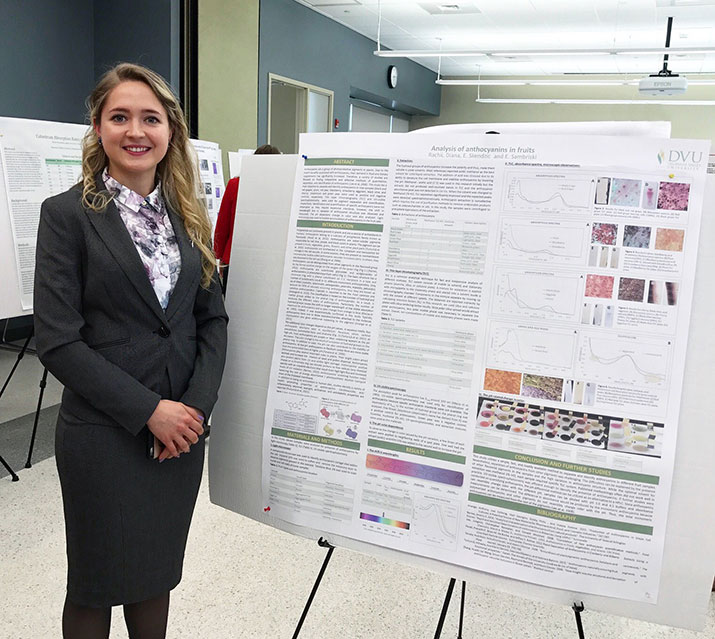DelVal Students Selected to Present Research at the Pennsylvania Academy of Science Annual Meeting
Two Delaware Valley University undergraduates have been selected to present scientific research at the 94th Annual Meeting of the Pennsylvania Academy of Science. The meeting will be held at Indiana University of Pennsylvania March 23 through March 25. Both students completed the work through the University’s Student Research course, which allows students to gain hands-on experience doing scientific research with faculty mentors. The course received funding from Bristol-Myers Squibb.
“Presenting scientific research as undergraduates will provide our students with professional experience and networking opportunities in their fields,” said Dr. Cynthia Keler, a DelVal professor of biology and chair of the Student Research Committee. “Delaware Valley University is proud to have two students selected to participate in this prestigious event.”
Diana Rachii ’19, a chemistry major and biology minor from Lansdale, Pennsylvania, will present “Analysis of anthocyanins in fruits” with DelVal Associate Professor of Biology Dr. Elizabeth Skendzic and Associate Professor of Chemistry Dr. Edward Sambriski.
Rachii combined methods from biology and chemistry to analyze fruit pigments. She focused on the study of anthocyanins, which mount an important defense system against oxygen radicals produced during energy intake in plants. The benefit of anthocyanins in human health is still an area of ongoing research. Anthocyanins are also currently being explored as energy-harvesting molecules for use in dye-sensitized solar cells.
Rachii received credit for the work through DelVal’s Experience360 Program. The Experience360 Program is a robust experiential learning program that provides real-world, hands-on experience for 100 percent of DelVal’s undergraduates before graduation.
"This research project was a milestone in my scientific career,” said Rachii who plans to pursue a graduate degree in chemistry after DelVal. “It has been a challenging, but quite rewarding journey where I gained a lot of knowledge and experience outside the classroom environment. I look forward to presenting and discussing my work at the 94th Annual Meeting of the Pennsylvania Academy of Science."
Dr. Sambriski said projects like Rachii's enable students to experience firsthand collaborations across disciplines.
“Interdisciplinary projects bolster coursework and bring students closer to real-world insights of scientific research in solving today's complex, multifaceted problems,” said Dr. Sambriski.
Dr. Skendzic said that undergraduate students often see the sciences as disconnected fields of study. She wants to help students understand, early in their careers, how the subjects they take relate to each other in practice.
“With the research project on fruit anthocyanins I wanted to focus on the fact that there are no real boundaries when it comes to the sciences and, particularly, when it comes to doing research,” said Dr. Skendzic.

Courtesy: Diana Rachii. Diana Rachii ’19, a chemistry major, will present research on fruit pigments.
Kelsey Stoneberg ’18, a biology major from North Royalton, Ohio, will present “Amplification of Oncorhynchus nerka COI gene from PIT tag trocars as a potential new field analysis technique” with Kimberly Johnston, a DelVal biology instructor.
Stoneberg and Johnston worked with Whooshh Innovations, a Seattle startup company which has developed a fish transport system to assist salmon over dams and ladders. Whooshh is involved in ongoing efforts to address declining numbers of salmon by studying their migratory patterns in the Pacific Northwest. These studies include trapping and PIT tagging fish with a transponder that tracks them as they move upstream to spawning grounds. Stoneberg’s research project was to determine if enough DNA can be extracted from used PIT tag trocars (an instrument used for delivery of the PIT tag) for identification of salmon species by DNA sequence analysis.
“The old way was to punch a hole in the tail,” said Stoneberg. “We wanted to see if enough DNA could be extracted from the used trocar. I discovered in a lab setting you can get enough DNA from the used trocar. My professor introduced the topic to me.”
This new method could eliminate the need for the tail punch, typically used by researchers in the field.
Professor Johnston said Stoneberg “did an outstanding job on her research project.” Johnston said the project gave Stoneberg the opportunity to “combine her passion for wildlife biology with current molecular biology techniques to answer a question that has a real-world application.”
The upcoming event will be Stoneberg’s first time presenting research at a professional meeting. After DelVal, she plans to go to graduate school and would like to work in wildlife conservation. She has been offered a graduate assistantship by Bowling Green State University for a master’s degree in biological sciences.
“At DelVal, I am working and learning directly from my mentor and also getting the chance to do the experiments on my own,” said Stoneberg of participating in Student Research, a DelVal course. “I like how I am getting hands-on experience to prepare for my future.”